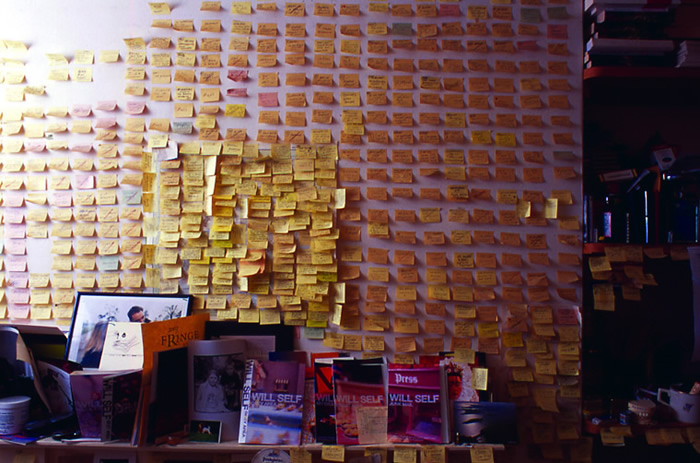The writer Chris Hall, that redoubtable Ballardian observer of the craziness of the modern inscape, recently sent me a link to an Evening Standard item on the redecoration of the Brixton branch of McDonald’s. It may well be that others of these low-esteemed eateries have been similarly tricked out; but if it’s Brixton alone, either the higher-ups in the chain’s chain are complete and utter bastards, or they’re unbelievably shrewd.
Anyway, the form this makeover takes is that the tables, the walls, the chairs and the very lampshades have all been bedizened with pseudo graffiti tags. Yes, yes, you’ve read me right: they’ve made the fast-food joint look as if it’s been subjected to a high-speed attack, in which a maddened crowd of hip-hopping taggers has invaded, armed only with spray cans and a collective identity crisis.
Chris appended the weblink with a cri from his own bitter coeur: “What next to complete the mise en scène – plastic dog turds on the floor? Or, er, their own-branded litter? In which case they could cut their own costs at the same time by sacking the cleaners . . .” But when I watched the online video clip I found out that Brixtonians themselves felt rather differently. True, there was one interviewee who said the new livery was a slur on the inhabitants, because it implies they’re all delinquent (or, worse still, the sort of idiots who think that a little bit of delinquency adds relish to a burger), but most of those the Standard spoke to used words such as “colourful” and “fun” to describe the patronising paint job.
What can we take away from this takeaway? Are we to assume that the denizens of Brixton are so sheepy that they don’t even realise when they’re being led by the nose? Or are they being ironic? Or could it be that they’re expressing a sincerely held opinion? Assessing the subtle inclination of such velleities interests me: in part because, a few years ago, I got involved in a similar situation – one that also altered the old, raddled and much-loved face of Brixton: I was approached by an arts organisation that was pitching for a commission to produce a piece of street art for Electric Avenue.
The piece was to occupy two large windows of the branch of Boots on the corner of Electric Avenue, which suffered damage in April 1999 when David Copeland, the infamous “London Nail Bomber”, planted one of his evil devices nearby. It’s perhaps a comment on Boots as much as Brixton that the windows remained boarded up for nigh on a decade.
Anyway, my idea for the piece was that I would hang out on the Electric Avenue around the market stalls, earwigging the conversations of traders and shoppers, and then edit this raw found dialogue into a series of phrases. These would be incorporated into a sort of electronic signboard, which would randomly light up one or other snippet of Brixton-speak to create a never-ending and ever-changing dialogue. I confess that I thought it a pretty nifty idea – and I was even a little bit proud to think a mind-child of mine would be taking such a prominent role in the vibrant street life of an area I have known and loved for many years (I live less than a mile away). So – I did my hanging out, gathered my snippets and I submitted these to the then Brixton town manager, a woman of impressive size but gentle mien.
When we next met, the town manager seemed a little worried. “The thing is,” she said, “some of the people on the planning committee feel that some of the phrases you’ve collected aren’t really representative of Brixton’s inhabitants.” Obviously, I demurred, reminding her that, far from being unrepresentative, the words had been uttered by real, live Brixtonians. But she remained adamant: the references to thieving, begging and drug-dealing would have to go. I confess that I slightly took my eye off the street-art ball at this point, so narked was I by the madness of censoring reality in this way. And there was more strangeness to come: I waited and waited for my piece to be installed on Electric Avenue, but then when it did happen it was a bit like the Stonehenge scene in This Is Spinal Tap: it looked like my electronic signboard as I’d conceived it – it behaved like my electronic signboard as well – but it was much, much smaller. In point of fact: it was tiny.
And it still is tiny – and still is there, at the end of Electric Avenue, in amongst all the hugger-mugger of the market, with its shoppers, its traders . . . and its beggars, petty thieves and minor drug dealers. If you happen to stop for a snack at the graffiti-decorated McDonald’s, why not make it a simulation double-header and check out my piece as well?
Brixton is currently at number one on the gentrification hit list, with local colour of all shades being annulled by the beige infill of hipsterdom. If things carry on this way, soon the only graffiti you’ll see in the area will be in McDonald’s, and instead of hearing racy dialogue, you’ll have to read it. I suppose this constitutes progress . . . and I look forward to Brixton’s risqué reputation being fully expunged when, in the not-too-distant future, reconstructions of the 1981 riots will be staged for tourists.
